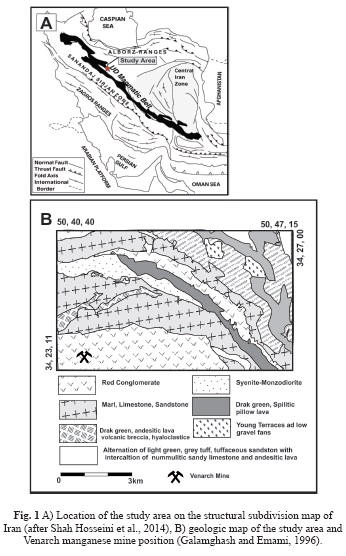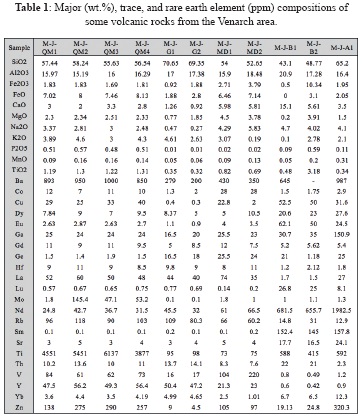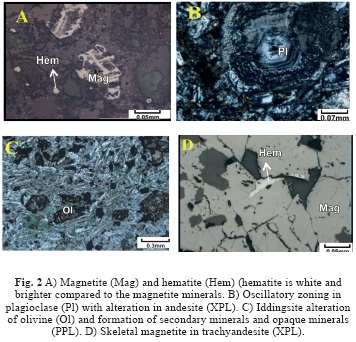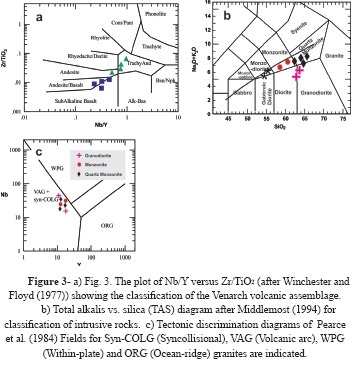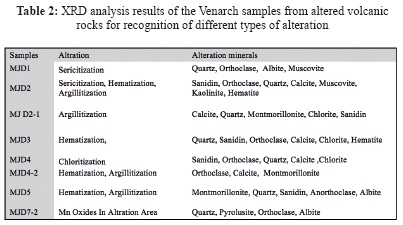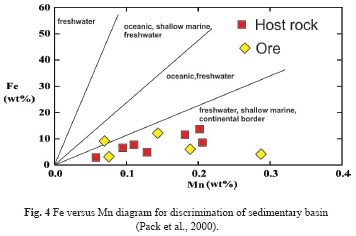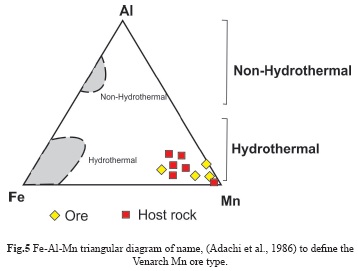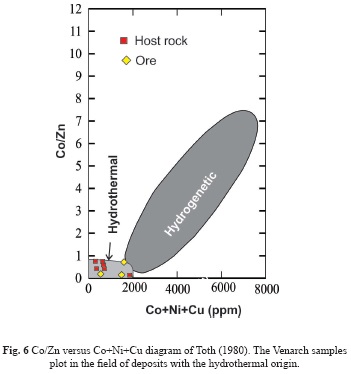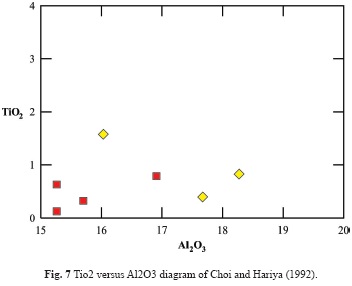Serviços Personalizados
Journal
Artigo
Indicadores
-
 Citado por SciELO
Citado por SciELO -
 Acessos
Acessos
Links relacionados
-
 Citado por Google
Citado por Google -
 Similares em
SciELO
Similares em
SciELO -
 Similares em Google
Similares em Google
Compartilhar
Earth Sciences Research Journal
versão impressa ISSN 1794-6190
Earth Sci. Res. J. vol.19 no.2 Bogotá jul./dez. 2015
https://doi.org/10.15446/esrj.v19n2.49372
http://dx.doi.org/10.15446/esrj.v19n2.49372.
ORE DEPOSITS
Magmatic Evolution and Compositional Characteristics of Tertiary Volcanic Rocks Associated with the Venarch Manganese Mineralization, Sw Qom, Central Iran
Evolución Magmática y Características de Composición en Rocas Volcánicas Terciarias Asociadas con la Mineralización de Manganeso en la Mina de Venarch, al Suroeste de Qom, en la Región Central de Irán
Mansoureh Mahdavi1, Rahim Dabiri2*, Elham Shah Hosseini3
1 Department of Geology, Science and Research Branch, Islamic Azad University, Tehran, Iran
2 Department of Geology, Mashhad Branch, Islamic Azad University, Mashhad, Iran
3 Department of Geology, North Tehran Branch, Islamic Azad University, Tehran, Iran.
*Corresponding Author: Rahim Dabiri (rahimdabiri@yahoo.com)
Record
Manuscript received: 26/02/2015 Accepted for publication: 20/06/2015
How to cite item
Mahdavi, M, Dabiri, R. and Hosseini E.S. (2015). Magmatic evolution and compositional characteristics of tertiary volcanic rocks associated with the Venarch manganese mineralization, SW Qom, Central Iran. Earth Sciences Research Journal, 19(2) 141 - 145 http://dx.doi.org/10.15446/esrj.v19n2.49372.
ABSTRACT
The manganese (Mn) deposits of Iran date from late Proterozoic to Pliocene but the major high-grade Mn ore deposits are associated with tertiary basic to intermediate volcanic rocks. The Venarch Mn deposit is located in the SW Qom city and considered as one of the largest in Iran. The Mn mineralization is mostly hosted by Eocene high-k volcanic and pyroclastic rocks of Urmia-Dokhtar Magmatic Arc (UDMA). The study area mainly consists of basalt, trachybasalt, andesite, and basaltic-andesite that are intruded by Eocene-Oligocene monzodiorite, monzonite, and granodiorite intrusions. The Venarch Mn ore bodies are mostly hosted by shale beds and wrapped by altered mega-porphyritic andesites and spilitic lavas both in the foot and hanging walls. Petrographic studies show that the principal ore minerals are pyrolusite, psilomelane, and other Mn-oxides, and quartz and calcite were determined as the gang minerals. Integration of field geology, petrography, and geochemical results suggest a hydrothermal origin for the Venarch Mn deposit. Our geochemical data furthermore suggest the volcanic host rocks to be comparable to high-K series of subduction zones.
Keywords: Geochemistry, Mn mineralization, Petrogenesis, Venarch, Central Iran.
RESUMEN
Los yacimientos de manganeso (Mn) en Irán datan del Proterozoico tardío hasta el Plioceno, pero el mayor grado de los depósitos de la mena de manganeso se asocian a rocas volcánicas básicas a intermedias de edad Terciaria. El yacimiento de manganeso en la mina de Venarch se localiza al suroeste de la ciudad de Qom y está considerado como uno de los más grandes de Irán. La mineralización de manganeso se presenta en su mayoría en las rocas piroclásticas y volcánicas de alto contenido de K del Eoceno en el Arco Magmático Urmia-Dokhtar (UDMA, en inglés). El área de estudio presenta basaltos, traquibasaltos, andesitas y andesitas basálticas que están intruidas por monzodioritas, monzonitas y granodioritas del Eoceno-Oligoceno. Los cuerpos de mineral de manganeso en Venarch en su mayoría están dentro de capas de pizarra y envueltos por lavas espiliticas y andesitas megaporfiroides tanto en las paredes del piso como en las colgantes. Los estudios petrográficos muestran que los minerales son pirolusitas, silomelanas y otros óxidos de manganeso, mientras que los cuarzos y las calcitas constituyen los minerales de ganga. La integración de los trabajos de geología de campo, petrográficos y geoquímicos sugieren un origen hidrotérmal del yacimiento de manganeso de Venarch. Los datos geoquímicos de este estudio también sugieren que la roca volcánica anfitriona es comparable con las series ricas en K de las zonas de subducción.
Palabras clave: Geoquímica, mineralización de manganeso, petrogénesis, Venarch, Irán central.
Introduction
Numerous manganese deposits have been found in different parts of Iran date from late Proterozoic to Pliocene (Förster, 1978; Laznicka, 1992; Roy, 2012; Samani, 1988). These deposits are widespread in the country but mostly occurred in the central and northern part of Iran (Shahabpour, 2007) (Fig. 1). The major manganese deposits of Iran are tertiary in age and can be classified into three broad genetic types: sedimentary, volcano-sedimentary, and hydrothermal. The Mn mineralization is mainly occurred in the Eocene volcanic rocks, particularly in the andesitic-dacitic lavas. However, Mn mineralization is also reported in some of post-Eocene granitic intrusions (Förster, 1978). The formation of manganiferous iron ores in the central Iran are thought to be associated with the pan-African metallogeny, and volcano-sedimentary deposits of Posht Badam area are proposed to be formed in a rift zone (Amidi et al., 1984; Foerster and Jafarzadeh, 1994; Moore and Modabberi, 2003). However subduction-related Mn deposits are considered as the most important manganese deposits in Iran such as Venarch, Robat Karim, Chah basheh, Bozni (Ghorbani, 2013). The Venarch manganese mine production is about 85000-100000 tons per year and is considered as the major producer of manganese in Iran (Tahmasbipoor and Fazeli, 2010). The Mn-rich layers and bands of the Venarch deposit contains 21.5-28.5% Mn. This deposit is genetically classified as one of the hydrothermal manganese deposits in a volcano-sedimentary environment (Makvandi et al., 2010). In this paper, we study the magmatic evolution and compositional characteristics of tertiary volcanic rocks associated with the Venarch manganese mineralization.
Analytical methods
A suite of 60 samples was collected from the mineralized zones and associated volcanic rocks representing different lithologies in the area. Among them, 24 samples from the least altered or deformed rocks were selected for petrographic studies, and 20 polished thin sections prepared for ore microscopy. After petrographic studies, a suite of 17 samples from the volcanic host rocks was analyzed for major and trace elements using X-Ray fluorescence (XRF) and inductively coupled emission spectrometry (ICP-ES), respectively (Table 1). The XRF and ICP-ES analyses were performed at the Zarazma Laboratory Ltd. in Tehran (Iran). A suite of 17 samples was analyzed for the mineralogical purposes using XRD machine at the Kansaran Binalood in Pardis Science and Technology Park (Iran).
Geological setting
The study area is located in the middle of Urmia-Dokhtar Magmatic Arc (UDMA), and located about 27 Km in the southwestern Qom city, and situated within longitudes 50º, 47', 57'' to 50º, 47', 10'' and latitudes 34º, 23', 54'' to 34º, 27', 35''. This area mainly consists of Eocene basaltic-andesite to andesitic volcanic rocks with tuff and other pyroclastic rocks with minor intercalated sedimentary lenses such as shale, gypsiferous marl, and shallow depth limestone (Aftabi and Atapour, 2000). Tectonic movements of upper Eocene caused the deposition of Lower Red Formation (LRF) which mainly consists of red beds of sandstone and siltstone intercalating the volcanic rocks (Reuter et al., 2009). The LRF itself overlies by marine Oligo-Miocene Qom Formation. The entire volcano-sedimentary strata are intruded by post-Lower Miocene granitoides and syenites intrusions (Amidi et al., 1984). The volcanic and volcano-sedimentary units in which Mn mineralization occurred mostly consist of mega-porphyritic andesite, spilitic lavas, tuffite, and tuff. In the Venarch deposit, the Mn mineralization forms a few centimeters to 1.5-meter lenses and alternating bands within shale, tuffite, and tuff layers. The mega-porphyritic andesites with large and white plagioclases set in a green to gray groundmass are also present in the Venarch area.
Petrography of host rocks
The Venarch manganese deposit is accommodated by volcanic and plutonic rocks. The volcanic strata mainly consist of basalt, trachybasalt, andesite, and basaltic andesite that are intruded by monzonite, monzodiorite, granodiorite, and syenite. The plutonic rocks are mostly granular in texture; however other textures such as graphic and poikilitic textures are present. The dominant minerals are plagioclase phenocrysts, quartz, K-feldspar, and hornblende and accessory minerals such as biotite, pyroxene, apatite, sphene, and opaque minerals can be seen in some of these rocks. The Venarch volcanic rocks are mostly porphyritic (the main texture in the samples), but other textures such as glomeroporphyritic, microlitic, and amygdaloidal textures are also present (Fig. 2a). Volcanic rocks consist of plagioclase, olivine, augitic pyroxene, and amphibole (Fig. 2).
Geochemistry of host rocks
In the Zr/TiO2×0.0001 versus Nb/Y diagram (Winchester and Floyd, 1977), which uses only relatively for immobile elements, the studied volcanic rocks plot in the fields of basalt, andesite, trachyandesite (Fig. 3a). The Na2O + K2O versus SiO2 diagram (Middlemost, 1994) shows the plutonic samples ploted in the monzodiorite to quartz monzonite (Figure 3b). By using the Irvine and Baragar (1971) boundary line, it is clear that the samples have a subalkaline affinity (Figure 3b). On the Ta versus Yb discrimination diagrams of Pearce et al. (1984), the rocks define a volcanic arc to syn-collision tectonic setting (Fig. 3c).
Discussion
Alteration
The Venarch manganese mine is associated with late Eocene basic to intermediate volcanic rocks (Tahmasbipoor and Fazeli, 2010). The basaltic and andesitic volcanic lavas and pyroclastic rocks are deposited in the sedimentary basin in which magmas are enriched in iron and to some extent manganese. Due to mafic magmatism and subsequent heat exchange, high-temperature hydrothermal fluids pass through the volcano-sedimentary rocks in the sedimentary basin, and elements such as Mn, Fe, Ca, and Si are therefore leached from the mafic rocks into the water. These elements are then precipitated as Fe- Mn oxides and hydroxides (such as goethite, hematite, magnetite, and manganite), and carbonates during the magmatic lull. Iron-manganese precipitation in the shallow depositional environment in the Venarch area has formed the bands of manganese, hematite, silica, and calcium carbonates. The Mn mineralization in Venarch deposit has occurred as bands, laminates, and manganese layers concurrent with the other volcano-sedimentary rocks. The manganese mineralization in the area is easily distinguished by their black color in the field. However, the secondary mobilization of the Fe-Mn oxides, silica, and carbonates is also evident in the area, which might happen during the final stages of Mn mineralization. During the later stages of ore formation, Mn filled veins and veinlets of fractures and joints of the host rocks. The mineralized horizons (laminate and bands) are locally boudinaged and cut by the veins and veinlets, indicating that the role of tectonic activities and fault rupturing during the late stage of Mn mineralization in the area. However, emplacement of Eocene-Oligocene intrusions have also affected the ore bodies in the Venarch mine deposit and produced different alteration minerals such as chlorite, epidote, serecite, and hematite.
Mn mineralization
The Venarch Mn mineralization consists of two different mineralized horizons called A and B. The Mn mineralization in the horizon A of the Venarch deposit is mostly formed as beds of hematitic shale in which there is no observed anomaly for the trace elements. This zone is Si-enriched, but recognized at he low-grade horizon, perhaps as a result of its far distance from the both mega-porphyritic andesite (as a source for Mn), and also far from the granitoides as a heat engine for hydrothermal fluids circulation. The B horizon is the lower mineralized horizon in the Venarch mine that exceed up to 580 m in thickness, and is made of two main thin and stretched mineralized lenses with the barren strata in between. This central horizon (B) is the economically important one in the Venarch manganese mine with a thickness of 800 meters of mineralized lenses conformable with the bedding and the maximum thicknesses between 2.1m and 3m. Sericitization, hematization, argillitization and chloritization alterations are observed in wall rocks around mineralizations (Table 2).
The ore horizons in the Venarch area are hosted by alternating shale beds and tuffs as laminates, layers, and bands. However, in some parts Mn mineralization presents as small black nodules in shale beds. Our field studies show that the Mn mineralization occurred conformable with volcano-sedimentary strata, and the high-grade horizons have taken place in the vicinity of volcanic lavas. In particularly, the shale beds close to the mega-porphyritic andesites and spilitic basalts show the highest grade, suggesting that the source rocks in the area controlled the degree of mineralization. In this regard, the deposit characteristics in the Venarch area and its formation in a shallow sedimentary basin is highly likely similar to the greenstone subgroup of Mn-rich formations. For example, the Olympic Island Mn deposit in the Washington (US) is one of the major Mn deposits, hosted by volcano-sedimentary strata of spilite, diabase, tuff, greywacke, limestone, and red shale and argillites.
Ore geochemistry
We used different variable diagrams (e.g. Fe-Mn and Fe-Al-Mn) to define the ore type and to understand the geodynamic setting of the sedimentary environment in which the Venarch deposit has occurred. The geochemical data show that the Venarch deposit samples plot in the field of freshwater and shallow marine continental margins (Fig. 4). Moreover, in the Fe-Al-Mn diagram the samples are manganese rich and hydrothermal (Fig. 5).
We also used the Co/Zn versus Co+Cu+Ni diagram of Toth (1980) to discriminate the Venarch samples, and results show that the samples plot in the field of hydrothermal deposits (Fig.6). Co/Zn ratio in the hydrothermal deposits is 0.15 and for hydrogenous deposits is above 2.5. This ratio for the Venarch samples varies between 0.003 and 0.11 and clearly represents their hydrothermal origin. Co, Ni, and Cu values are usually used to distinguish the hydrothermal from the hydrogenous deposits (deep marine manganese nodules), and Zn values are mainly sources from continents (Bonatti et al., 1972). The data indicate that the Venarch samples have lower values for Co, Ni, and Cu, suggesting their hydrothermal origin. Titanium is an immobile element during hydrothermal alteration and can be used as an indicator of the amount of detrital sediments from continents in deposits (Sugisaki, 1984). The higher values of Ti in the Mn deposits represent the higher amount of detrital sediments in the sedimentary rocks. Accordingly, the Venarch deposit sample has lower content of TiO2, which is correlated with the lower amount of Al2O3, implying that samples hydrothermal origin (Fig. 7).
Conclusions
The Venarch Mn deposits are associated with late Eocene basaltic-andesitic volcanic rocks and formed in a shallow sedimentary basin in an intra-arc or retroarc tectonic setting. The Venarch Mn deposit host rocks are volcanic and plutonic rocks. Volcanic rocks include basalt, trachybasalt, basaltic andesite and andesite and plutonic rocks consist of monzonite, granodiorite, monzodiorite, and quartz monzonite. The dominant minerals are plagioclase phenocrysts, quartz, K-feldspar, and hornblende and accessory minerals such as biotite, pyroxene, apatite, sphene, and opaque minerals can be seen in some of these rocks. Mn mineralization occurred as bands, laminates, layers, and small nodules in the shale and tuff beds conformable with volcano-sedimentary strata and the high-grade horizons have taken place in the vicinity of mega-porphyritic volcanic lavas. According to the geochemical results for the major and trace elements of the study area, volcanic rocks are sub-alkaline and calc-alkaline and belong to subduction-related volcanic arcs, but plutonic rocks are formed in a volcanic arc and or syn-collisional setting. The ore geochemistry of the Venarch samples suggest that they have formed by hydrothermal alteration and is similar to marine hydrothermal Mn deposits.
References:
Adachi, M., Yamamoto, K., and Sugisaki, R. (1986). Hydrothermal chert and associated Siliceous rocks from the northern Pacific: Their geological significations indication of ocean ridge activity. Sedimentary Geology, v. 47, p. 125-148. [ Links ]
Aftabi, A., and Atapour, H. (2000). Regional aspects of shoshonitic volcanism in Iran. Episodes, v. 23, no. 2, p. 119-125. [ Links ]
Amidi, S. M., Emami, M. H. and Michel, R. (1984). Alkaline character of Eocene volcanism in the middle part of Central Iran and its geodynamic situation. Geologische Rundschau, v. 73, no. 3, p. 917-932. [ Links ]
Choi, J. H. and Hariya, Y. (1992). Geochemistry and depositional environment of Mn oxide deposits in the Tokoro Belt, northeastern Hokkaido, Japan. Economic Geology, v. 87, no. 5, p. 1265-1274. [ Links ]
Foerster, H. and Jafarzadeh, A. (1994). The Bafq mining district in central Iran; a highly mineralized Infracambrian volcanic field. Economic Geology, v. 89, no. 8, p. 1697-1721. [ Links ]
Förster, H. (1978). Mesozoic-Cenozoic metallogenesis in Iran. Journal of the Geological Society, v. 135, no. 4, p. 443-455. [ Links ]
Galamghash, J. and Emami, M. H. (1996). The Geological Map of Kahak quadrangle. Geological Survey of Iran, scale 1:100000. [ Links ]
Ghorbani, M. (2013). The Position of Iranian Mining Industry in the World, The Economic Geology of Iran. Springer, p. 297-332. [ Links ]
Irvine, T. N. and Baragar, W. R. A. (1971). A guide to the chemical classification of the common volcanic rocks. Canadian Journal of Earth Sciences, v. 8, no. 5, p. 523-548. [ Links ]
Laznicka, P. (1992). Manganese deposits in the global lithogenetic system: Quantitative approach. Ore Geology Reviews, v. 7, no. 4, p. 279-356. [ Links ]
Makvandi, S., Mohaghegh, B., Boojar, M. M. A. and Akbar, M. (2010). Biogeochemistry of Manganese: Case study in Venarch mine, Iran, in Proceedings Geochim Cosmochim Acta2010, Volume 74, Pergamon-Elsevier Science Ltd The Boulevard, Langford Lane, Kidlington, Oxford Ox5 1gb, England, p. A660-A660. [ Links ]
Middlemost, E. A. (1994). Naming materials in the magma/igneous rock system. Earth-Science Reviews, v. 37, no. 3, p. 215-224. [ Links ]
Moore, F. and Modabberi, S. (2003). Origin of Choghart iron oxide deposit, Bafq mining district, Central Iran: new isotopic and geochemical evidence. Journal of Sciences Islamic Republic of Iran, v. 14, no. 3, p. 259-270. [ Links ]
Pack, A., Gutzmer, J., Beukes, N., Van Niekerk, H. and Hoernes, S. (2000). Supergene Ferromanganese Wad Deposits Derived from Permian Karoo Strata along the Late Cretaceous-Mid-Tertiary African Land Surface, Ryedale, South Africa. Economic Geology, v. 95, no. 1, p. 203-220. [ Links ]
Pearce, J. A., Harris, N. B. and Tindle, A. G. (1984). Trace element discrimination diagrams for the tectonic interpretation of granitic rocks. Journal of Petrology, v. 25, no. 4, p. 956-983. [ Links ]
Reuter, M., Piller, W., Harzhauser, M., Mandic, O., Berning, B., Rögl, F., Kroh, A., Aubry, M.-P., Wielandt-Schuster, U. and Hamedani, A. (2009). The Oligo-/Miocene Qom Formation (Iran): evidence for an early Burdigalian restriction of the Tethyan Seaway and closure of its Iranian gateways. International Journal of Earth Sciences, v. 98, no. 3, p. 627-650. [ Links ]
Roy, S. (2012). Ancient manganese deposits. Handbook of stratabound and stratiform ore deposits, v. 7, p. 395-476. [ Links ]
Samani, B. A. (1988). Metallogeny of the Precambrian in Iran. Precambrian Res, v. 39, no. 1, p. 85-106. [ Links ]
Shahabpour, J. (2007). Island-arc affinity of the Central Iranian volcanic belt. Journal of Asian Earth Sciences, v. 30, no. 5, p. 652-665. [ Links ]
Tahmasbipoor, K. and Fazeli, A. (2010). Preparation of Red Pigment from Manganese Tailings of Venarch Mine (Qom). GEOSCIENCES, v. 20, no. 77, p. 3. [ Links ]
Toth, J. R. (1980). Deposition of submarine crusts rich in manganese and iron. Geological Society of America Bulletin, v. 91, no. 1, p. 44-54. [ Links ]
Winchester, J., and Floyd, P. (1977). Geochemical discrimination of different magma series and their differentiation products using immobile elements. Chemical Geology, v. 20, p. 325-343. [ Links ]













